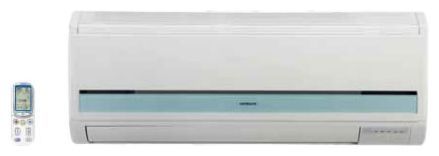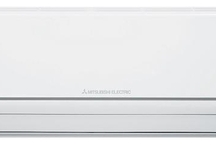
Specifications
| General characteristics | |
|---|---|
| Type of | wall split system |
| Inverter (continuously adjustable power) | there is |
| Maximum length of communications | 20 m |
| Main modes | cooling / heating |
| Maximum airflow | 8.5 cu. m / min |
| Power in cooling mode | 2500 watts |
| Power in heating mode | 3400 W |
| Heating power consumption | 795 W |
| Cooling power consumption | 580 W |
| Fresh air mode | there is |
| Drainage Mode | there is |
| Control | |
| Remote control | there is |
| On / Off Timer | there is |
| Dimensions | |
| Indoor unit split system or mobile air conditioner (WxHxD) | 79x29.8x21 cmn |
| Split system outdoor unit or window air conditioner (WxHxD) | 75x54.8x28.8 cmn |
| General | |
| Indoor unit noise level (min / max) | 20 dB / 40 dB |
| Refrigerant type | R 410A |
| Phase | single phase |
| Fine air filters | there is |
| Fan speed adjustment | there is, the number of speeds - 3 |
| Other functions and features | the ability to adjust the direction of the air flow, the system against the formation of ice, the memory function settings |
| Permissible range min. temperatures for operating the air conditioner | from -15 to -10 ° С |
| Additional Information | air quality sensor |
Reviews of conditioner Hitachi RAS-10JH4
Virtues
- At low speed - quiet. You can sleep. The relatively wide shutter allows you to direct the flow down and along the ceiling, almost horizontally.
disadvantages
- No backlight in the control panel. It is not comfortable. Rotary shutters for re-directing the flow in a horizontal plane of small size and not quite cope with their task, the air blows actually straight. In the supply and exhaust air supply mode - the additional fan is noisy.
Comment
If you choose this model because of the function AirExchange, then before buying it will be better to read the installation instructions (posted here: http://narod.ru/disk/23367553000/%D0%98%D0%BD%D1%81%D1 % 82% D1% 80% D1% 83% D0% BA% D1% 86% D0% B8% D1% 8F_% D0% BF% D0% BE_% D1% 83% D1% 81% D1% 82% D0% B0 % D0% BD% D0% BE% D0% B2% D0% BA% D0% B5_Hitachi_10_jh4.pdf.html).
Depending on the direction of the tube output for air exchange (left or right of the indoor unit) it is proposed to use tubes with a diameter of 25mm or 20mm. For what the manufacturer recommends to drill a hole in the wall with a diameter of 65-80 mm. This is more than what installers usually drill. Therefore, it is better to clarify before ordering: 1. What hole are they going to drill to install this model of air conditioner. 2. The diameter of the pipe (duct), assemblers are going to bring out (25 mm for the exchange of air - this is so little). 3. Did they personally read the manufacturer's instructions for installing a specific model with the air exchange function?
In the instruction manual (which would also be a good idea to read before purchase, and not after), the Working Principles section indicates the conditions under which air will not be supplied to the room, including: If there is a difference in air temperature (inside and outside) more than 7 hail. in cooling mode (due to condensation).
(working principle: http://narod.ru/disk/23414593000/%D0%9F%D1%80%D0%B8%D0%BD%D1%86%D0%B8%D0%BF_%D1%80%D0 % B0% D0% B1% D0% BE% D1% 82% D1% 8B_Hitachi_10_jh4.pdf.html)
PS: The idea of air exchange in air conditioners is generally correct, manufacturers need a bolder implementation.
walker1632, 2010-08-04 Evaluation 4
Virtues
- Very low noise level
- Elegant appearance
- The combination of price / quality
disadvantages
- In my opinion, the intake ventilation is still an unhelpful option.
Comment
1) For some reason, many people scold the console like a shovel, like a shovel. For me - so very elegant and comfortable remote control.
2) Supply ventilation. And good and bad. The very idea of low noise ventilation of the room seemed very tempting (there is an undesirable way to open windows under the windows of the house).In fact, the supply fan is very noisy, you can sleep at the first, smallest rotational speed, and even that is noisy. The airing rate was also not very satisfied, a slightly open window in this regard copes much more efficiently. And finally, the most important thing is that the air intake in order to avoid condensate will not work when the outside air temperature is less than +3 degrees. Those. in the offseason, this function will quickly stop working.
3) Air conditioning was very pleased. The noise level is extremely low, the wall clock ticks louder than the first speed. Of course, in the summer it will be more clear, but so far the heating / cooling is very satisfied.
4) Shutter. The fact that after reading such reviews, the similar Panasonic was noted off (well, because of the latter’s high price too :)) At Hitachi, it opens not from the bottom, but from the sides in the middle. Those. and a hole remains above and below. Most of the air, of course, flows horizontally, but also blows it down. The fundamental difference in the matter between the shutters Hitachi and Panasonic NO. The disadvantage of the curtains of this air conditioner is too small backlash angle, which can be adjusted from the console. Familiar prompted to stand on a chair and adjust the curtains by hand - which we do, to the horror and fear in Smart Japanese.
So, the choice is still very satisfied, the only thing is not quite sure about the utility of ventilation. Next time I will most likely stop on a similar model, but without additional costs for the inflow.
golovanov.pv, 2011-04-11 Evaluation 5
Virtues
- Silent fan of the internal block, pleasant design, inflow / extract
disadvantages
- Noisy outdoor unit, remote control without backlight, noise in the mode of inflow / exhaust
Comment
Impressions for 2 weeks of operation
Works in a room of about 17 square meters, a volume of about 50 cubic meters, in the room one workplace with a constantly running PC, south side, window of medium size
There is an effect from the influx (or at the placebo level?) - there is no keen desire to stand up and open the window from time to time, but the interior door usually does not close, so the experiment's purity is broken
The inflow / exhaust noise (the motor pump buzzes, the air in the corrugation), does not distract you from work at minimum and average speed, but I will not put such an air conditioner in the bedroom for anything.
If you do not include the inflow / exhaust, the internal unit is very quiet, convenient control logic from the console. There is no backlight on the console, for the bedroom it would be a fat minus.
The outdoor unit, on the contrary, makes a noise no less than the old non-inverter Midei nine; a year later, rubber washers were placed on the brackets under it - the resonant hum at certain compressor revolutions was greatly reduced.
P.S. The manufacturer does not write anywhere how much cube. m. per hour pumps / pumps out the inflow and exhaust of this air conditioner. such a moraketing intrigue.
It is understandable why, through the inch tube, these values will be shameful and will not reach the standards for submarines and places of detention.
But in practice, the effect is felt; when serving, some pressure is created in the room adjacent to the kitchen - kitchen smells do not come into the room.
PS.2 A year has passed, and I can add to the above that the logic of temperature control is going crazy - it cools adequately only when it is very hot outside. in other cases, when setting from 16 to 21 indoors, the thermometer turns out 23-34, does not always respond adequately to the console, the reboot does not help, the pressure of freon was measured - normal.
And again PS After several very hot days, the air conditioner suddenly came to its senses and began to cool the room smoothly and adequately. I start to be afraid of him - it seems that he considers himself smarter than me.
Schlange mark 2013-08-19 Evaluation 4
Virtues
- The presence of the inflow for the money
- Workmanship, materials
disadvantages
- Inflow is frankly noisy and inefficient.
- Unclear automatic mode.
- Others have not yet found.
Comment
Introductory: odnushka 38 m2, room 20 m2, brick factory under the windows. :) A week of operation.
In principle, I was warned that the inflow would be weak, but I did not expect so much.
In addition, it will not be possible to use it in the winter - there are restrictions, automatic protection. It is possible only in summer and autumn - the temperature difference outside and inside is not more than 7 degrees.
In principle, it is needed mainly in the summer, but this is not all of its shortcomings. It is very noisy, including the weakest mode in which it barely blows at all, but you can sleep. :) It is much noisier than the main fan, and the flow gives worse. It is inconveniently implemented to control it: with the 1st button you go through 3 extract intensities, 3 inflows and switch off.
Kondeya's reaction to management is not entirely clear, but you may need to get used to and understand.
Overall rating - good condo. The deficiencies described above prevented him from being excellent, but here it is a matter of taste and habits.
One thing I will say for sure - I chose it because of the function of ventilation (Air Exchanger), and at the moment I am completely disappointed with it.
In general, following the results of using this kondeya during the week, I concluded that I chose the brand successfully, but I had to buy the cheapest one, since need infrequently, but too weak for air exchange.
UPDATE:
Following the results of the second year I update - I put 5 stars.
Inflow mode is not used - too noisy and weak.
It is very good on a hot night - you set the temperature and the minimum airflow - it perfectly maintains the microclimate, and is hardly audible. If you do not sleep right under it - you will not catch a cold.
His remote is really uncomfortable. As a result, the on / off keys, mode, speed, temperature are used. Everything.
He heats too great. In the off-seasoning saves - the heater is not needed.
There are not enough swinging side blinds (they are only installed by the hands, and they can swing up and down automatically).
Summary - great condo. But it is better to look for a similar model without an inflow - there is no point in overpaying for it.
Prokhorov Yevgeny, 2013-09-13 Evaluation 5
Virtues
- Cool, you can set the temperature to +16 (in the office mitsubishi, there is only up to +18). Also in low noise mode it is almost inaudible. Heats well, too, in general with the main functions copes with ur. Design nogrmal, remote pleasant. The main advantage that is all that is required.
disadvantages
- VERY damn instruction to start using it is not needed at all, but in order to understand all the functions and subtleties of its operation it is obviously not enough, I had to wool the Internet to understand all the subtleties of Japanese technology. Noisy ventilation mode, but knew in advance and there is no alternative, so do not complain. When there is no smoke, it is easier to open the window for ventilation. The mode of automatic air purification cleans so-so, therefore, having understood its uselessness, I do not turn it on. Otherwise, everyone is happy.
Comment
Many people write that the curtains poorly regulate the direction of the air, because of this, I almost refused to buy this model. In fact, I did not notice anything like this, everything is fine as it should be. NGIArt, the self-cleaning function turns on automatically after a long work in cooling / drying mode, the main thing is that the corresponding button is pressed. Since in the self-cleaning mode it dries the air duct and the indoor unit, it turns on the heating in this mode, therefore it is better to turn it on when there is no one in the room, as the room heats up. Regarding the automatic mode, the temperature can be changed within +/- 3 degrees from the PROTECTION in the system, could not figure it out for a long time, since there are no details in the instructions. In principle, this is enough, the temperature corresponding to 0 is somewhere around 24-25 degrees. In fact, this mode is needed if you have a big house or you hang it in an office or shop, and you forget. It is more convenient to use simple cooling or heating when necessary.
kselevanov 2011-05-23 Evaluation 5
Virtues
- quiet + comfortable remote control + metal filter
- supply and exhaust ventilation
disadvantages
- in the mode of forced-air ventilation, you do not fall asleep at night, but during the day with a general noise --- closed the windows and sleep. No longer breathe the old air
- nano filter for a long time, but do not wash --- what then?
Comment
For a long time I chose different models, in the general I studied almost everything. I stopped at the inverter. Although his bonus is for those who do not understand the essence, After all, all the same, every 4 hours, you need to open the windows and let in a fresh air - that is, replace it with a warm street one. Therefore, it is necessary not to close the windows to the end (airing) But then the condender will work all the time, which is NOT what the inverter does is to blow cold air stupidly.
Budget models dismissed immediately. I appreciate the quality + reliability, but they are not cheap. Therefore, Beko, Balu, Kuntatts (well-advertised as a young man) did not look. Chinese assembly too. (By the way, therefore, Electrolux fell out ... he was all from there) Why did he dismiss? --- Malazia is only 2-3 thousand more expensive, and there are fewer claims on them compared to the same brand, but the Chinese one. (this is not an iron for you - I took it and carried it in for repair) Therefore, I guided it to 25-30000 thousand per room at 20 meters. Mitsubishi-- expensive (for 40 it turned out) Daikin-- especially (there you generally pay 30% for the brand). Fujitsu-- plastic is full of gray, but by pricelessness is inferior to Panasonic. LG and Samsung - in general stable troeshniki. Therefore, in the general stopped at Panasonic - there are no complaints, quiet, not expensive, there are all sorts of gadgets, but .. I have a child, and he plays on the floor, and according to all reviews from Panasonic, the flow control flap does not become horizontal and the cold air is all equals also at an angle of 20%.
That came to Hitachi. The very appearance and quality of execution --- like in Mitsubishi. Very comfortable remote. Sooo quiet. Metal mesh (In Panasonic - just gauze with metal streaks --- type of ionization) Inside the filter on the principle of the machine (only narrow and long --- nano filter). Filter on the air from the street
Buy and do not think. If it smoothes the inflow, there is a model RAS-10SH1. Hitachi-- not deservedly not advertised model. The level is clearly above the Panasonic LG Samsung. Totzhe Mitsubishi - only 10,000 denchevle TAKE !!!
Anonim 2010-06-27 Evaluation 5
Video review air conditioner Hitachi RAS-10JH4



